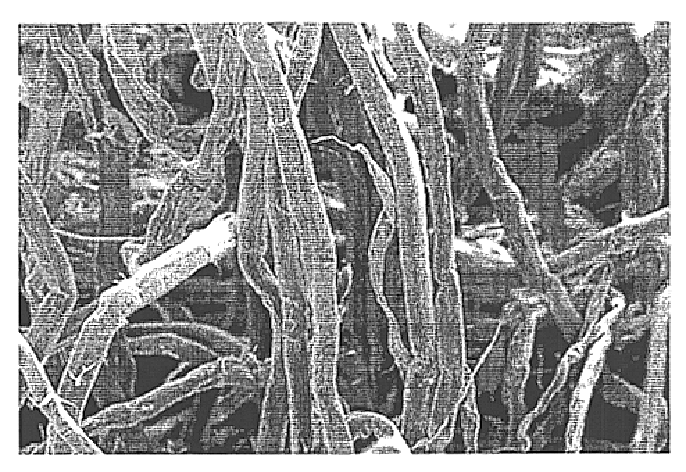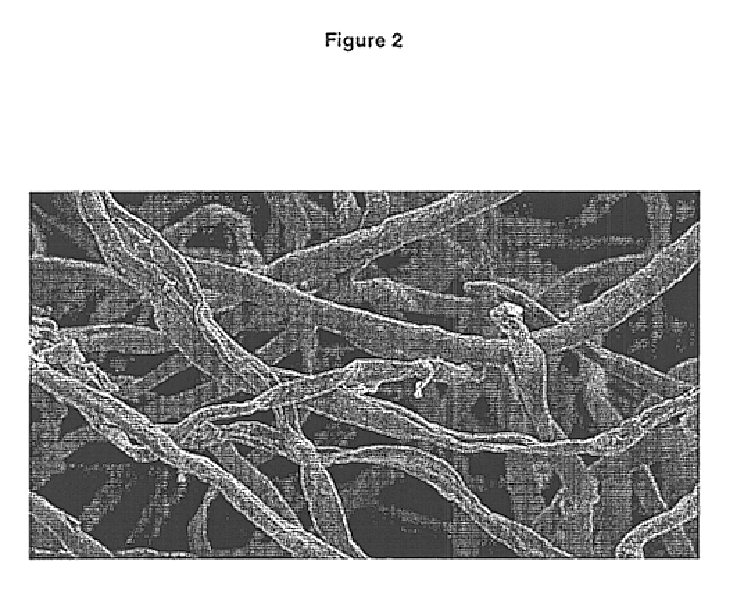Superabsorbent cellulosic fiber and method of making same
a cellulosic fiber and superabsorbent technology, applied in the field of cellulose-based fibers, can solve the problems of affecting the use of consumer absorbent products, affecting the use of cellulose-based superabsorbent materials, and the tendency of natural-based superabsorbent materials to form soft, gelatinous masses, etc., to achieve enhanced porosity, reduce gel blocking, and more porous
- Summary
- Abstract
- Description
- Claims
- Application Information
AI Technical Summary
Benefits of technology
Problems solved by technology
Method used
Image
Examples
example 1
This example provides a representative method for making superabsorbent fiber of the present invention at high consistency.
A sample of never dried Rayfloc®-J-LD was obtained as a 33.7% solid wet lap from a Rayonier mill at Jesup, Ga., and is an untreated southern pine Kraft pulp sold by Rayonier Performance Fibers Division, Jesup, Ga. and Fernandina Beach, Fla. for use in products requiring good absorbency, such as absorbent cores in diapers. A 40.0 g (dry weight basis) sample was suspended in an aqueous solution (1.0 L, taking into consideration the amount of water present in the never dried pulp) of acrylic acid (180.0 g), and methylenebisacrylamide (5.0 g). The mixture was agitated for about 15 min, then excess liquid was removed by suction filtration (centrifuge, or mechanical pressing) to obtain a fiber with a pick-up of about 110.0 g. This pick-up affords about 20.0 g of acrylic acid and 0.55 g of methylenebisacrylamide on fiber. The treated fiber was charged in a 2 L Pyrex re...
example 2
A sample of never dried Porosanier-J, obtained as a 43.3% solid wet lap from a Rayonier mill at Jesup, Ga., (a mercerized fiber commercially available from the Rayonier mill at Jesup, Ga.). A 40.0 g (dry weight basis) sample was suspended in an aqueous solution (1.0 L, taking into consideration the amount of water present in the never dried pulp) of acrylic acid (180.0 g), and methylenebisacrylamide (5.0 g). The mixture was agitated for about 15 min, then excess liquid was removed by suction filtration (centrifuge, or mechanical pressing) to obtain a fiber with a pick-up of about 110.0 g. This pick-up affords about 20.0 g of acrylic acid and 0.55 g of methylenebisacrylamide on fiber. The treated fiber was charged in a 2 L Pyrex reaction kettle equipped as described in Example 1. The fiber in the reaction kettle was agitated and purged with nitrogen gas for at least 30 min to remove oxygen. Then pottasium persulfate (0.5 g in 100 mL distilled water) was added drop-wise via a syringe....
example 3
A sample of Porosanier-J Fiber (40.0 g) treated with acrylic acid and methylenbisacrylamid solution as described in example 1 was loaded in a horizontal high Parr reactor (Parr Instrument Company, Moline, Ill.). The reactor was connected to a vacuum pump, a cylinder of an inert gas, and to a high-pressure sample cylinder via Teflon tubing. The fiber in the reactor was degassed by pressurizing it using an inert gas such as N2 and evacuating it using a vacuum pump for at least two times. An aqueous solution of an initiator described in Example 2 was added to the high pressure sample cylinder and degassed by pressurizing it using N2 and evacuating it using vacuum pump. While the gas addition cylinder containing the initiator under a positive pressure and the Parr reactor containing the treated fiber under vacuum the initiator was added slowly to the fiber while being agitated. After the addition of the initiator solution was completed, the Parr reactor was pressurized to about 50 psi u...
PUM
| Property | Measurement | Unit |
|---|---|---|
| dry density | aaaaa | aaaaa |
| insult acquisition time | aaaaa | aaaaa |
| acquisition time | aaaaa | aaaaa |
Abstract
Description
Claims
Application Information
 Login to View More
Login to View More - R&D
- Intellectual Property
- Life Sciences
- Materials
- Tech Scout
- Unparalleled Data Quality
- Higher Quality Content
- 60% Fewer Hallucinations
Browse by: Latest US Patents, China's latest patents, Technical Efficacy Thesaurus, Application Domain, Technology Topic, Popular Technical Reports.
© 2025 PatSnap. All rights reserved.Legal|Privacy policy|Modern Slavery Act Transparency Statement|Sitemap|About US| Contact US: help@patsnap.com



